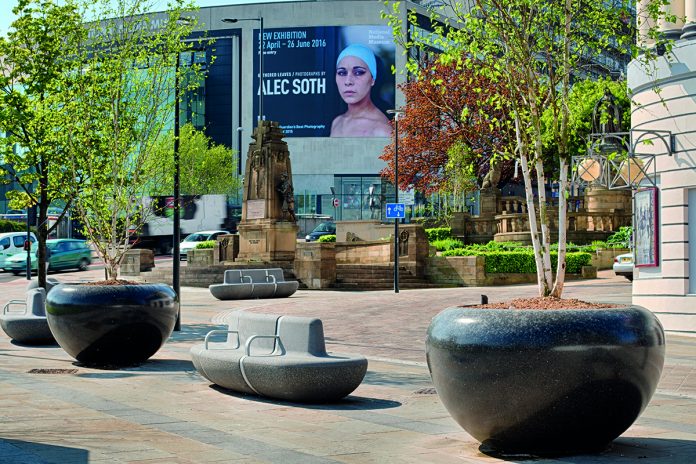Jaz Vilkhu, Managing Director of Landscape Protection argues that urban planners must consider a holistic approach to protection against terrorists
Terrorist organisations are now increasingly focused on using vehicles to kill, maim and cause panic. But rather than erecting concrete barricades in defence, Jaz Vilkhu, Managing Director of Landscape Protection at Marshalls, argues that urban planners must consider a holistic approach focusing on protection and design to ensure people don’t feel a continual threat.
Vehicles have become the weapon of choice for terrorists. Stripped down to the bare-bones of an individual with motivation, intent and access to a car, van or lorry, the attacks we’ve seen across Europe over the last few years have cut the time between planning an attack and execution to a matter of hours.
This new threat is far more difficult to predict and has so far prompted a primitive and unsophisticated response, which has become a blanket reaction across our towns and cities. According to the 2017 EU Terrorism Situation & Trends report, the increase in the number of anti-terror barrier installations around landmarks, key infrastructure and public spaces with high footfall has reflected the sharp rise in vehicle attacks.
But fortifying urban areas in this way can convey mixed signals. Yes, concrete barricades send a clear message that threats are taken seriously, but in doing so they remind the public of the need for protection and creates an environment of fear. In a recent Guardian article, columnist Simon Jenkins noted: “Parts of central London already look cowed and afraid, as ugly barriers go up around tourist sites.”
Reducing the perception of risk
It’s clear that such Hostile Vehicle Mitigation (HVM) measures can unnerve the public and feed the feeling of imminent threat. And while the battle is primarily against terror, addressing this perception should be just as key a priority for those designing and securing cities from terrorist or criminal activity. It’s a vicious circle: the higher the perception of risk, the greater threat individuals feel. This applies directly to the presence of visible anti-terror security measures, which have been found to increase levels of suspicion, tension and fear among the public.
It’s a reaction that is hardwired into the human brain. Anxiety worsens cognitive functioning as our attention is drawn away from day-to-day life and towards the threatening stimuli that confronts us. In seeking to protect places, the very action of fortifying our town and city centres is increasing the fear that people feel. This can all too easily translate into action, with falling footfall severely hitting businesses and urban areas.
Tackling the issue through aesthetic design
Installing protective measures can change the nature of these urban spaces and addressing this presents a new challenge. In her study, Invisible Security: The Impact of Counter-Terrorism on the Built Environment, Rachel Briggs writes: “It has been argued that ‘security’ has become the justification for measures that threaten the core of urban social and political life – from the physical barricading of space to the social barricading of democratic society – that rising levels of security in cities will reduce the public use of public space.”
To allay this, urban designers should look to adopt a holistic approach to ensure that protection is integrated in a way that doesn’t change how people feel about and use their town and city centres. In essence, using measures that are unobtrusive and can be hidden in plain sight.
It’s pleasing to see that these considerations are increasingly forming part of urban security planning. Architects, city planners and security experts are less willing to compromise on aesthetics when it comes to security. According to a recent report we produced with IFSEC Global, 79% of these professionals have seen the number of projects requiring aesthetically focused perimeter protection increase over the last three years. In addition, 94% believe that demand will ramp up across both the UK and EU.
Deter, deflect and defend
One option is a multi-layered strategy that is designed to reduce the threat long before a vehicle can reach its target, while in keeping with an environment’s aesthetics. As a first step, designers could look at limiting the speed or mitigate the angle of approaching traffic. This could include changes to the layout of the road network, the addition of traffic calming features, such as chicanes, speed bumps, restricted-width lanes, and the creation of pedestrianised areas and ‘buffer zones’, which demarcate traffic from pedestrian areas. Secondly, new kerbing systems can be installed to deflect oncoming vehicles back on the carriageway and away from vulnerable areas.
Rather than using concrete blocks or metal barriers as a defensive line to implement a high level of HVM, architects should consider reinforced landscape furniture such as planters, seating, litter bins, lighting columns, cycle stands and bollards. Although these products look like regular landscape furniture, they are built with fortified PAS 68/IWA 14.1 certified cores. This is the latest Publicly Available Specification for products used to assist in terrorism prevention, which specify a classification for vehicle security barriers and their foundations when subjected to impact. The foundations can be built to varying depths and using the strongest specification, a single piece of furniture can stop a 7.5-tonne articulated lorry travelling at 50mph.
From shopping centres and sports stadia to rail stations, leisure venues and our high streets, any space where people gather is now considered to be at risk. But protecting those spaces is a complex balance between making people feel safe and like they’re not living in a controlled, militarised environment. Given the potential social and commercial impacts that metal barriers and concrete barricades can have, it’s vital that future risk assessments on infrastructure and public spaces focus on aesthetics, keeping protective measures out of sight and out of mind.
Please note: this is commercial profile
Abigail Kellett
Product Manager
Marshalls PLC
Tel: 01422 312000
Abigail.kellett@marshalls.co.uk
www.marshalls.co.uk/landscapeprotection
image credit: Image: © 2016 Sarel Jansen











